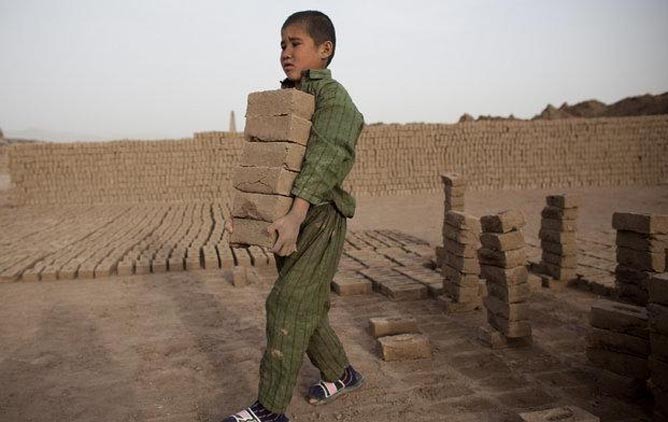
Though the government has passed Bonded Labour Abolition Act in 1992, it has failed to change the fate of bonded labourers due to poor implementation

With times slavery also keeps on changing its forms and it impacts people in different ways. Of them one is modern slavery which is a product of feudalism as it is liable to bring us under different shades of slavery. Feudalism and slavery goes hand in hand. Elimination of modern slavery by 2030 is part of Goal 8 of the Sustainable Development Goals (SDGs) to which Pakistan is a party. Pakistan has also ratified ILO Convention No 29 and 105 which calls for the abolition of slavery.
According to Global Slavery Index 2016, Pakistan ranked third out of 167 countries, which is very alarming as it amounted to tarnishing Pakistan’s image in international community and may impact us negatively in economic terms. According to this survey, over two million people, 1.13 per cent of total population, are victim of modern slavery in Pakistan. Modern-day-slavery includes but not limited to bonded labour, forced labour, labour trafficking, forced marriage and commercial sexual trafficking. Of it, debt bondage is worst type of modern slavery which is prevalent in the brick making, agriculture and carpet-weaving industries. Bonded labour literally rules the large tracts of southern Punjab and Sindh. Virtually, children in these bonded families are born only to suffer and die in endless slavery.
Debt bondage, debt slavery and bonded labour are the names given to the workers entrapped in such type of slavery. Bonded labour can be defined as a person’s pledge of labour or services as security for the repayment of a debt or other obligation. But generally bonded workers’ women and children are also caught up in this slavery in a vain attempt to pay off the debt. In this way the whole family ends up in slavery which sometimes passes to future generations. Sexual exploitation of women working at kilns is also a routine matter. In most of the cases CNICs of the bonded labourers are snatched away by employers in order to eliminate a chance of labourers’ mobility and keeping their power of possession over them intact. There are also incidences of keeping private jails by kiln owners for physical violence and torturing of bonded labourers. Sometimes purchase and sale of brick-kiln labour has also been witnessed which is a slap on the face of humanity.
The people trapped in modern slavery are fated to live in abject poverty. Like formal sector victims of kilns are not covered and protected by labour laws. Most of the labourers working at kilns suffer worse than jail prisoners; they don’t have the facility of safe drinking water, toilet, adequate food and proper place to rest. They don’t have provision of fixed working hours -- on an average a worker is forced to work for eight to eleven hours and is exposed to harmful gases emanating from furnaces which are liable to raise the temperature to unbearable limit, particularly in summer. Their housing conditions are also extremely poor; no drainage, no electricity and no toilet. Health and educational facilities are still a distance dream for the children of kiln workers.
Though government has passed Bonded Labour Abolition Act in 1992, this act remained only on papers owing to its limited publicity and absence of larger public awareness initiatives. Under this act anyone working as bonded labourer was no longer under any obligation to repay any part of his or her bonded debt. This law was very strict as it introduced punishment for anyone who enforced a bonded debt by forcing a debtor to work. District magistrates were also empowered to enforce the law, monitor the working conditions and look after the release and rehabilitation of bonded labourers. Establishment of district level Vigilance Committees were also part of this act which were to include representatives of civil society, district administration, bar association, media and Labour Department. But this act could not achieve the desired results because District Magistrates as well as Vigilance Committees were not aware about their roles and responsibilities.
Similarly, kiln owners and bonded labourers did not know about the penalty and protection respectively in case of violation of this act. It brings us to the fact that despite legislation kiln owners operate freely instead of persecution. This indicates the reality that kiln owners seemed to be more powerful than the writ of the state.
Though other certain labour laws too exist but they are toothless with weak implementation mechanism. More importantly political will required to implement these laws lacked to a great extent. Feudal lords sitting in the parliament and other traditional power structures are there just to serve their own narrow interests. They use and see bonded labourers as fuel of kiln’s furnace rather than human beings.
A multi-pronged strategy is required for the protection, rehabilitation and development of bonded labourers. Scope of labour laws must be extended to informal sector like brick-kiln workers, landless farmers, peasants, etc. There must be an effective mechanism for registration of bonded labourers with NADRA, Employee’s Old Age Benefit and Social Security Department so that they may have social protection to some extent. Moreover, their children must have access to education under Article 25-A of the constitution.
State must undertake necessary arrangements to comply with this basic need of citizens, particularly the most marginalised. Bonded workforce must also organise themselves in order to negotiate for their rights. Last but not the least, media should also raise the voice of downtrodden people like the bonded labourers. Now it is the time to show zero tolerance against modern slavery.
The writer is development practitioner with South Asia Partnership-Pakistan. He can be reached at zubairtahseen.sh@gmail.com